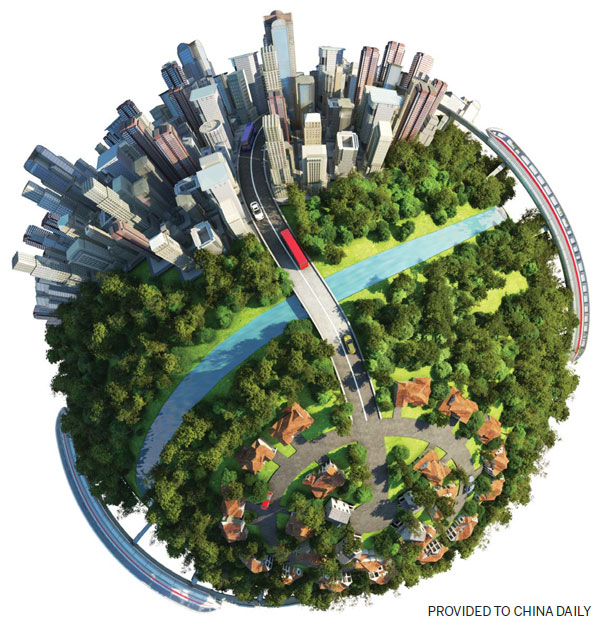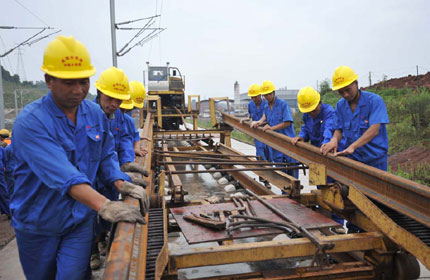Urban future
Updated: 2014-07-04 08:11
By Karl Wilson in Sydney (China Daily Europe)
|
|||||||||||

Asia must avoid outdated Western strategies and chart its own destiny
"Cities are cultural artefacts," says Tom Kvan from the University of Melbourne in Australia. "They must reflect the culture of the way people live and wish to live."
And as Asian cultures use space in a different way to those of the West, the region needs to evolve a different way of planning the cities of the future, rather than following an outmoded European or US model.
This issue is particularly pertinent right now as Asia's urban population rockets. In China, for example, it has been estimated that by 2030, 1 billion people will be living in cities, making it the most urbanized country in the world.
Building projects have been fast-tracked on a massive scale to accommodate the change, says Steffen Lehmann, director, China-Australia Centre for Sustainable Urban Development, at the University of South Australia.
China is moving away from megacities and urban clusters to smaller, more sustainable, "eco-cities", he says.
"I think this is the way forward," he says.
An expert in sustainable design and behavior, Lehmann has been an adviser to the government of Singapore for more than 10 years and a senior researcher with the United Nations Economic and Social Commission for Asia and the Pacific, whose headquarters are in Bangkok.
But just building more is not enough. Lehmann says that as urban population soars in Asia, governments face a "huge problem with urban planning".
In Manila, the urban sprawl is home to anywhere from 15 to 20 million people, many of whom live in slums. Choked with traffic, the city - once known as the Pearl of the Orient due to its central location within the Pacific's sea trade routes - is an urban planner's worst nightmare.
Something similar can be said of Jakarta, whose official metropolitan area is one of the largest agglomerations in the world with a population of more than 28 million. And Bangkok, which was known as the Venice of Asia in the early 20th century because of its network of canals, has seen most of them filled in to make way for roads.
But such sprawling, traffic-choked conurbations are not the only examples of urban living in Asia. Some planners are looking to places like Hong Kong and Singapore for inspiration when it comes to urban planning, especially in confined spaces.
According to the global consultancy McKinsey & Co, 3.6 billion people, or half of the world's population, live in cities. This is the highest in mankind's history and the number is growing dramatically.
In Asia, more than 122,000 people drift into cities daily from the countryside, looking for a better life and work. McKinsey estimates that within the next 15 years more than 5 billion people, roughly 60 percent of humanity, will be living in cities, most of them in Asia.
While developed Asia - Japan, South Korea, Hong Kong and Singapore - has the money to cope with an expanding urban population, it is the developing countries that are struggling to deal with urbanization on an unprecedented scale.
All are fighting to secure or maintain the competitiveness of their cities and the livelihoods of the people who live in them.
And all are aware of the environmental legacy they will leave if they fail to find more sustainable, resource-efficient ways of managing these cities.
Simple things that are taken for granted by so many - such as garbage collection, infrastructure, a clean environment, parks and recreation facilities - all go into the mix.
The Manila-based Asian Development Bank estimates that by 2022 more people in Asia will be living in cities than in the countryside. This will put enormous strain on services ranging from education, health, transport and housing to water, sanitation and even garbage disposal.
The ways in which cities develop and cope with such rapid urbanization are of huge importance to citizens who live there. But their development matters to others too.
Cities are the main source of global economic growth and productivity, and they account for most resource consumption and greenhouse gas emissions. Urban development, therefore, matters to the well-being of all the world's occupants.
But the question is: How to make cities of the future livable and sustainable?
Lehmann from the University of South Australia says that the rapid urbanization of the region is presenting some serious challenges that need to be addressed. "We have to rethink the future of urbanization in Asia, and it won't be easy," he says.
"The megacities or urban clusters we have seen develop in China in recent years are not the answer, and even the government recognizes that now."
The development of smaller and more sustainable eco-cities could offer a solution, and some Chinese urban areas are already offering an example to the rest of the region.
"In China, eco-cities can be new cities, built from the ground up, or redesigns of existing cities like Chengdu," Lehmann says, referring to the capital of Sichuan province in Southwest China.
"These are government initiatives where private developers are sold parcels of land according to a master plan. However, more and more communities are being included in discussions. This grassroots participation in the process is something very new to China, but is growing."
The concept could be reproduced in Asia, albeit not everywhere, he says. "There is not a lot you can do with cities like Bangkok, Manila or Jakarta. They are simply too big and too complex to undo and rebuild."
Lehmann says second- and third-tier cities hold the key for many countries. In Tianjin, for example, the Chinese and Singaporean governments are developing an eco-city with features such as a light rail transit system and integrated waste management. When ready in the mid 2020s, it will be able to accommodate about 350,000 people.
"But even these cities are growing three to four times faster than big cities like Bangkok or Manila," Lehmann says, predicting that in 10 or 15 years, the population of some of these smaller cities could rise from a few million to as much as 10 million.
Governments need to invest now so they can put new infrastructure in place, he says. Lehmann also warns that today's planners should not make the same mistakes as in the past, when urban planning was based on outdated urban models. "Second- and third-tier cities can be turned into green cities, and I think that is the way forward for Asia. You cannot change cities like Shanghai or Beijing, Jakarta or Manila for that matter."
karlwilson@chinadailyapac.com
(China Daily European Weekly 07/04/2014 page14)
Today's Top News
Gambling costs World Cup fans their lives
US supports Ukraine's decision to suspend ceasefire
It's all about making a spectacle
China likely to see 7.5% growth in second quarter
Palace Museum feeling the squeeze of visitors
Myanmar pagoda replica given to China
US sends 300 more troops to Iraq over concerns
Hong Kong at the crossroads
Hot Topics
Lunar probe , China growth forecasts, Emission rules get tougher, China seen through 'colored lens', International board,
Editor's Picks

|

|

|

|

|

|





